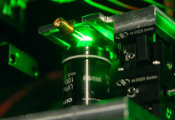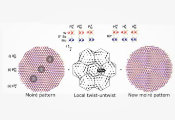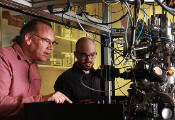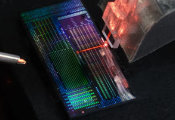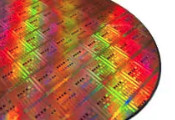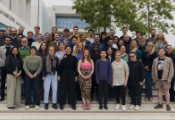Red Lasers Grown on Silicon Chips Could Power the Next Generation of Quantum and Sensing Technologies
October 28, 2025 -- Researchers at the University of Illinois Urbana-Champaign (UIUC) and MIT Lincoln Laboratory have, for the first time, demonstrated visible red lasers grown directly inside a silicon nitride photonic chip—a type of microchip that guides light rather than electricity. Silicon nitride is a key material for technologies that rely on light, such as quantum computing, biosensing, and augmented reality, but it cannot generate light on its own. Materials made from elements in columns III and V of the periodic table—known as III–V compounds—are widely used to make commercial lasers, yet their crystal structures and processing requirements make them difficult to integrate with silicon-based materials such as silicon nitride.
“Developing this platform required bridging the worlds of III-V materials growth and silicon nitride integrated photonics,” said Yiteng Wang, lead author and Ph.D. candidate in materials science and engineering at Illinois. “It was incredibly rewarding to see how years of process development and close collaboration with MIT Lincoln Laboratory converged into a working red laser grown right inside a silicon nitride photonics chip.”
“This work brings visible-light photonics a step closer to the scalability and integration that silicon photonics has achieved in the infrared,” said Minjoo Larry Lee, professor of electrical and computer engineering and Director of the Holonyak Micro and Nanotechnology Laboratory (HMNTL) at UIUC, who led the Illinois effort.
The collaborative project built upon extensive efforts to mitigate material defects that arise during the growth of III–Vs on silicon-based photonic platforms. The silicon nitride photonic templates were manufactured on 200 mm silicon wafers at MIT Lincoln Laboratory and featured precisely defined microscopic “pockets” for the growth of indium phosphide (InP) quantum dot lasers at UIUC. III-V lasers with high densities of nanoscale quantum dots have shown promising performance and reliability, even in the presence of crystalline imperfections. The team is now developing fabrication techniques for optical coupling into silicon nitride waveguides, enabling new types of visible photonic systems.
Professor Richard Mirin from the University of California at Santa Barbara, who was not involved in this work, said, "This is an exciting development for integrated photonics at visible wavelengths. While there has been significant prior work on integrated semiconductor lasers at telecommunications wavelengths, this new work shows the opportunity for shorter wavelength lasers, which are especially important for quantum sensing and information."
The work was primarily supported by the Defense Advanced Research Projects Agency (DARPA) LUMOS program, managed by Gordon Keeler and Anna Tauke-Pedretti, under the project “Heteroepitaxial III–V/SiNₓ Integrated Photonics (HIP)”. Senior author Minjoo Larry Lee is an affiliate of the Department of Materials Science and Engineering and a member of the Illinois Quantum Information Science and Technology Center (IQUIST).


